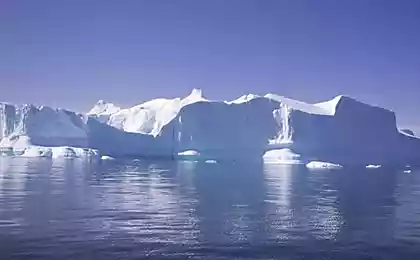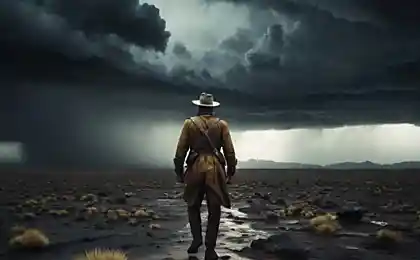1332
Expedition to Earth
Franz Josef Land - an archipelago in the Arctic Ocean in the north of Europe. It was opened on August 30, 140 years ago, when the Austrian polar expedition stumbled on the Arctic archipelago. Blogger Dmitry managed to visit this place during an expedition to the North Pole aboard the nuclear-powered icebreaker "50 Years of Victory".


Despite mid-summer the next day after our departure from the port of Murmansk, we started to come across the ice floe.
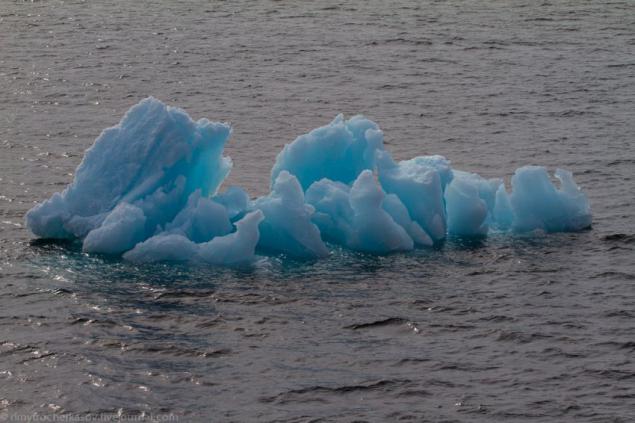
Very soon gave way to spend some floe ice fields. They began to come across small icebergs.
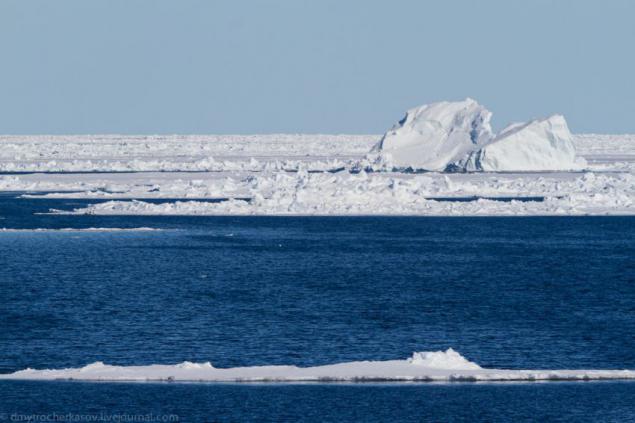
In this area, we met the first polar bears. This is not surprising. This combination of ice, land and water - an ideal habitat for this polar predator.

The main prey of polar bears this seal. He tracks down her mainly by smell. Very often seal hides in the gullies in the ice. Displayed on the surface too often it is not in danger. Polar bear tracked down the seal with full force its front paws hit the ice and then tries to pull her out. This bear is clearly too late. Someone more successful already dealt with the seal.

Trusting your nose, polar bears are able to climb the far north from the nearest land. They have no natural enemies. They are not social animals and prefer to live alone. The only exception - a mother with small cubs. Mother bear feeds not only the beginning of his life but also protects against adult males. From time to time they attack the cubs.

Although they are able to overcome dozens of kilometers across the icy wilderness is still a favorite habitat for them is a combination of earth, ice fields and the open water. Bears great swim in the water, but once again prefer not to go there. Small cracks in the ice, they can easily jump.

After a successful hunt the bear is not capable of weeks. Therefore, they are saturated in store. Just dined bear can be easily recognized by a huge belly.

Due to the fact that the natural enemies they have, bears a rather curious. Of course, most of them prefer to stay away from the nuclear icebreaker. All the same, the difference in size is colossal. But some looked fit directly to the board and try to see what is happening on the deck.

Especially pleased with all the bear with very little bear. They circled around at least an hour. This was unusual, because often, at the slightest danger of a female trying to steal the baby away.
Here they came to the ship for a long time circling on ice floes.

We watched with great interest because of their relationship.

Trying to better see what is happening on the board, even a bear climbed on an iceberg.
We were almost at the level of her eyes. It was probably the most interesting acquaintance with bears for the time of the expedition.

We were almost at the level of her eyes. It was probably the most interesting acquaintance with bears for the time of the expedition.

In addition to polar bears, walruses we have yet come across. They are less fearful than the seals. Although adult bear is sometimes able to handle land and walrus. In the water, they feel quite safe. Often their rookeries are located directly on the large ice floes.

However, when approaching a large ship often prefer to dive into the water. There they were much more comfortable and the speed with which they swim a lot more than a clumsy movement on land.

Large males are all covered with scars from fights with their neighbors. Every great walrus seeks to protect his harem and territory from pesky competitors. So they have to spend most of the battles of life.

Two days later, the way we come to the first island of the archipelago of Franz Josef Land. The existence of land to the east of Spitsbergen predicted by many scientists. It was once said even Lomonosov. One of the most fundamental research in this regard was made by Peter Alexeyevich Kropotkin. He even calculated the coordinates of the island. Unfortunately, funds for the expedition did not find. Therefore, the discovery of the islands has been made completely by accident. The Austro-Hungarian expedition of Charles Weyprecht and Julius Payer was trying to find the Northeast Passage but was clobbered by ice near the New Earth. Gradually drift brought them steam schooner sailing to the shores of the archipelago. It happened on August 30 in 1873. Therefore, newly discovered land was named in honor of the Austrian Emperor Joseph I.
Fratsa

Expedition leader of our trip was the famous Canadian explorer Lorrie Dexter. Based on ice conditions around the island, it was decided to land on the shore by helicopter. Inflatable boats "Zodiac" could not get close enough to the landing. We had to go ashore at Cape Flora on the island of Yuri Kuchiev. It is interesting that the island is one of the youngest in the archipelago. It was opened in 2008 during the expedition of the icebreaker "Yamal". Prior to that, between the islands it was the isthmus and it was part of the island Northbrook. But the team found that the nuclear submarine isthmus washed away with water. Thus on the map, a new island. He was named in honor of the legendary captain of the icebreaker "Arktika". It was under his command for the first time in human history the surface vessel reached the top of the worlds - the North Pole.
Aboard the icebreaker was MI-8 helicopter with a crew. Typically, these large helicopters are not used for real work in the sea. For ice reconnaissance rather more economical and smaller MI-2. However, in our case it is supposed landing of people and the delivery of equipment, so the choice fell on this type of helicopter.

These tasks only by experienced crews. Not only must sit and take off from a small area on the ship, but also wisely choose a place to land, and to make sure that there is no danger to the surrounding people. During landing or ice the main problem was the polar bears. First of all it was necessary to make sure that they are not around.
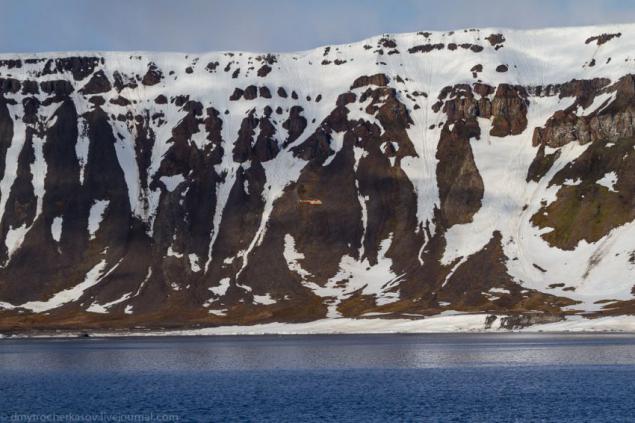
Near the landing rises 300 meter mountainside. It nest thousands of birds. This is mainly guillemots and white seagulls. The black dots around the helicopter - it's just a bird in the air.

The first landed people on shore to ensure the safety of the rest of the group. Hunting of polar bears is prohibited by law. And although they are armed, but the bullets used to scare away the beast. On the defeat of one does not shoot. In order to avoid bounce a steel core. So you can shoot on the stones and drive away the bear. In addition, there are stun grenades.

Place our landing - Cape "Flora". At this point repeatedly landed Arctic expedition. For the first time here I wintered British yacht crew of "Air", under the command of Benjamin Lee Smith. His ship was jammed in the ice near the place. The researchers were able to build a shack from scrap materials, and spend the winter on the island. In the spring, they are four sloops reached the New Earth, where they were picked up, and the British ship sent to your searches.
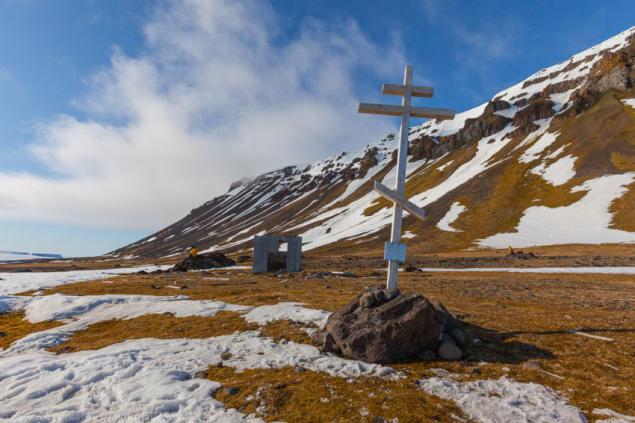
British polar explorer and geographer Frederick Jackson founded a fixed base during an expedition to study the Franz Josef Land. 17 June 1896 is based came to the Norwegian researchers Fritor Hjalmar Johansen and Nansen after his failed attempt to reach the North Pole.

We stayed at this place American Walter Wellman expedition on the steamer "Fridtjof" and Duke Arbutstsi to "Stella Polare».
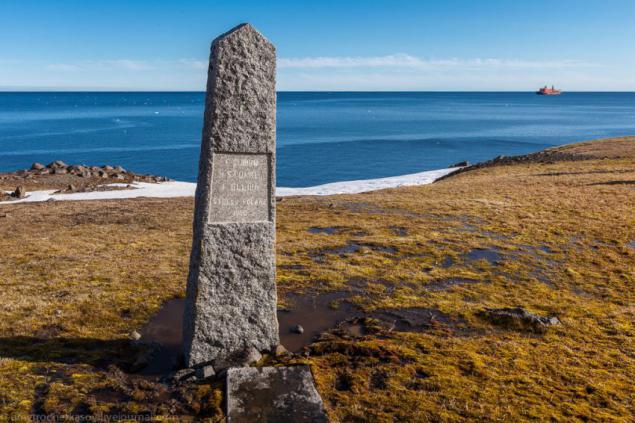
Many polar expeditions have used brown coal mine which is on the island. It is interesting that during the winter Sedov, a neighboring island on the schooner "The holy martyr Thomas" did not know about it. They were desperate for fuel and dismantled for the construction of the wooden base.

This is just a small part of the history of Arctic exploration in the region. Officially, the archipelago has been declared Russian territory during the expedition Ishaq Ibrahimovic Islyamova searching Sedov in 1914. Just then there was raised the Russian flag.

No less striking in the history of this place the beauty of northern nature. Summers are short but very bright. Throughout underfoot moss covered with colorful flowers. One has only to step on the carpet and immediately sank into the water on the knee.

Constantly heard did not cease bird din. The surrounding rock was chosen by thousands of guillemots and gulls.
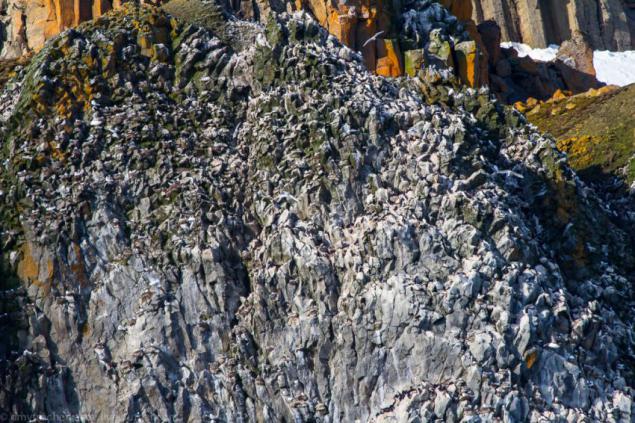
They nest literally everywhere these basaltic rocks. Only glaciers are free from avian settlements.

Come in here and polar bears. The islands are also common fox, walrus, seal, bearded seal, harp seal, narwhal and beluga. A little south of the sea can be seen killer whales. But this visit we did not get to see any animals. Only the old bones.

Back we flew one of the last helicopters. I want as long as possible to take a walk around the island and enjoy the local beauty. And I must say that we succeeded fully.

Almost immediately after take-off, we felt a strong vibration. The helicopter lost altitude rapidly at first and then set on the left at the next turn of the Cape. I sat in the tail and heard how much creaking tail boom.

After a while we sat on the ground and it became clear that we take off the blade hit one of the many guillemots. Because of this, the ending of the propeller deformed.

It was decided to carry on the rescue of all bots on the other side of the bay. There has been ice-free coastline. After the evacuation of people from the island, the crew of the helicopter on their own try to fly on board the icebreaker.

Thus we had the "wonderful" opportunity to admire the beauty of the island in plenty during this landing. However, the transition was not so very long. Most of the path fell on the hill so the walk was relatively easy.
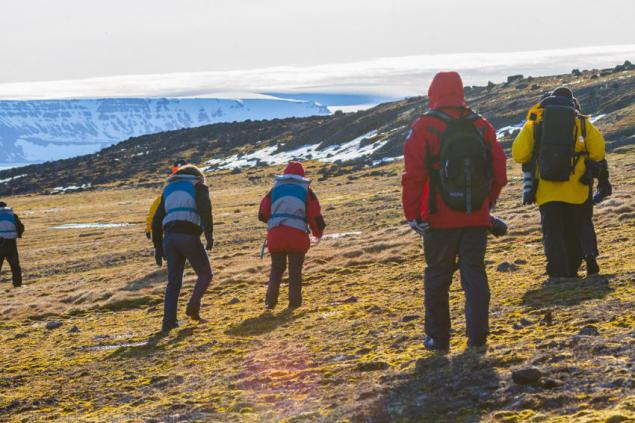
Rescue boat slowly approached shore soundings to inadvertently damage the screw.

And then several flights have transported and equipment on board.
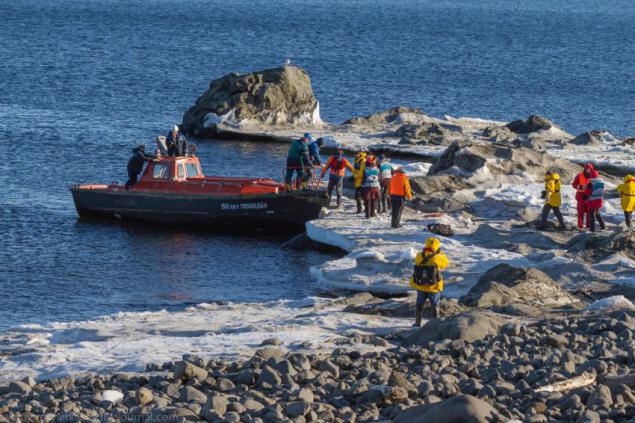
Despite the eventful day to sleep that night, we did not succeed. This time of year the sun does not go beyond the horizon so the light continuously. Passing close to the rest of the archipelago, we constantly encounter polar bears. Well here it is possible to miss the opportunity to get acquainted closer with the wildlife of the Arctic?

The second time near Earth Fratsa Joseph islands we visited on the way back home from the North Pole.

First of all, we come to the basalt rock Roubini. It is named after the famous Italian tenor and his interesting ogomnym rookeries.
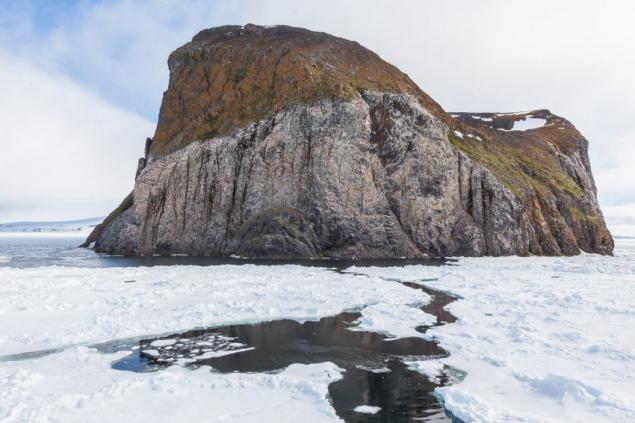
Due to the volcanic origin of the rocks around the coast is very steep. Therefore, even such a huge ship like our nuclear icebreaker is able to approach it almost came. This is a very impressive sight. In order to guide such a delicate surgery on the nose is one of the sailors with a portable radio. He always tells the distance to the rocks and the trend movement.

Basalt slopes of the island are dotted all birds. It is also interesting to observe the structure of the rocks that seem collected from the individual flat bars.

But the main purpose of our re-entry was a quiet bay on the island of Hooker. It was here in 1929 was opened the first in the archipelago Soviet research station.
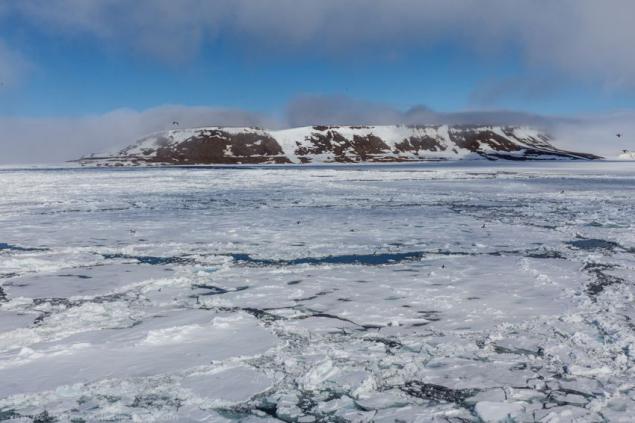
Unfortunately by the time of our visit at the station for several years no one lived. All the buildings on the site have been preserved, and the only inhabitants were here except polar bears. Aboard the icebreaker were members of the first in all that time the expedition to the island. They were to go ashore and to assess the recoverability of this polar base. Before planting they are most concerned by the question of having uninvited guests from among the bears. Therefore, all the time before sending it to the shore, they carefully studied the structure of the bank and binoculars. Due to the ice to approach the shore on boats not possible. Therefore, the landing was carried out again by helicopter. During the trek to the Pole of ship mechanics were able to fix the ending and MI-8 was again ready to fly. The other passengers on the island is not planted. Visibility in this day unfortunately was not very good. Therefore, as soon as the little all cleared up immediately boarded a helicopter and flew to the island.
That turned my visit to Franz Josef Land during an expedition to the North Pole.
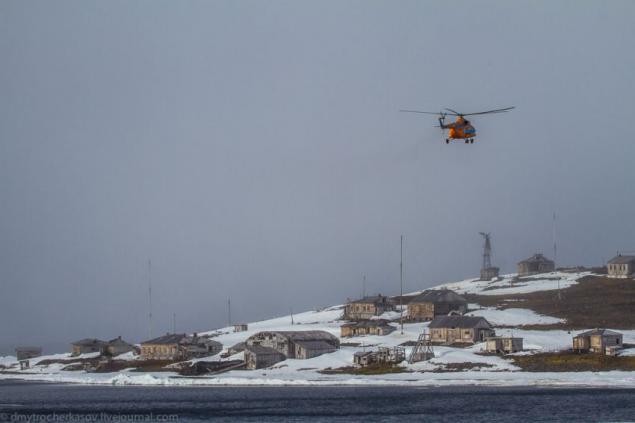
Source: dmytrocherkasov.livejournal.com


Despite mid-summer the next day after our departure from the port of Murmansk, we started to come across the ice floe.

Very soon gave way to spend some floe ice fields. They began to come across small icebergs.

In this area, we met the first polar bears. This is not surprising. This combination of ice, land and water - an ideal habitat for this polar predator.

The main prey of polar bears this seal. He tracks down her mainly by smell. Very often seal hides in the gullies in the ice. Displayed on the surface too often it is not in danger. Polar bear tracked down the seal with full force its front paws hit the ice and then tries to pull her out. This bear is clearly too late. Someone more successful already dealt with the seal.

Trusting your nose, polar bears are able to climb the far north from the nearest land. They have no natural enemies. They are not social animals and prefer to live alone. The only exception - a mother with small cubs. Mother bear feeds not only the beginning of his life but also protects against adult males. From time to time they attack the cubs.

Although they are able to overcome dozens of kilometers across the icy wilderness is still a favorite habitat for them is a combination of earth, ice fields and the open water. Bears great swim in the water, but once again prefer not to go there. Small cracks in the ice, they can easily jump.

After a successful hunt the bear is not capable of weeks. Therefore, they are saturated in store. Just dined bear can be easily recognized by a huge belly.

Due to the fact that the natural enemies they have, bears a rather curious. Of course, most of them prefer to stay away from the nuclear icebreaker. All the same, the difference in size is colossal. But some looked fit directly to the board and try to see what is happening on the deck.

Especially pleased with all the bear with very little bear. They circled around at least an hour. This was unusual, because often, at the slightest danger of a female trying to steal the baby away.
Here they came to the ship for a long time circling on ice floes.

We watched with great interest because of their relationship.

Trying to better see what is happening on the board, even a bear climbed on an iceberg.
We were almost at the level of her eyes. It was probably the most interesting acquaintance with bears for the time of the expedition.

We were almost at the level of her eyes. It was probably the most interesting acquaintance with bears for the time of the expedition.

In addition to polar bears, walruses we have yet come across. They are less fearful than the seals. Although adult bear is sometimes able to handle land and walrus. In the water, they feel quite safe. Often their rookeries are located directly on the large ice floes.

However, when approaching a large ship often prefer to dive into the water. There they were much more comfortable and the speed with which they swim a lot more than a clumsy movement on land.

Large males are all covered with scars from fights with their neighbors. Every great walrus seeks to protect his harem and territory from pesky competitors. So they have to spend most of the battles of life.

Two days later, the way we come to the first island of the archipelago of Franz Josef Land. The existence of land to the east of Spitsbergen predicted by many scientists. It was once said even Lomonosov. One of the most fundamental research in this regard was made by Peter Alexeyevich Kropotkin. He even calculated the coordinates of the island. Unfortunately, funds for the expedition did not find. Therefore, the discovery of the islands has been made completely by accident. The Austro-Hungarian expedition of Charles Weyprecht and Julius Payer was trying to find the Northeast Passage but was clobbered by ice near the New Earth. Gradually drift brought them steam schooner sailing to the shores of the archipelago. It happened on August 30 in 1873. Therefore, newly discovered land was named in honor of the Austrian Emperor Joseph I.
Fratsa

Expedition leader of our trip was the famous Canadian explorer Lorrie Dexter. Based on ice conditions around the island, it was decided to land on the shore by helicopter. Inflatable boats "Zodiac" could not get close enough to the landing. We had to go ashore at Cape Flora on the island of Yuri Kuchiev. It is interesting that the island is one of the youngest in the archipelago. It was opened in 2008 during the expedition of the icebreaker "Yamal". Prior to that, between the islands it was the isthmus and it was part of the island Northbrook. But the team found that the nuclear submarine isthmus washed away with water. Thus on the map, a new island. He was named in honor of the legendary captain of the icebreaker "Arktika". It was under his command for the first time in human history the surface vessel reached the top of the worlds - the North Pole.
Aboard the icebreaker was MI-8 helicopter with a crew. Typically, these large helicopters are not used for real work in the sea. For ice reconnaissance rather more economical and smaller MI-2. However, in our case it is supposed landing of people and the delivery of equipment, so the choice fell on this type of helicopter.

These tasks only by experienced crews. Not only must sit and take off from a small area on the ship, but also wisely choose a place to land, and to make sure that there is no danger to the surrounding people. During landing or ice the main problem was the polar bears. First of all it was necessary to make sure that they are not around.

Near the landing rises 300 meter mountainside. It nest thousands of birds. This is mainly guillemots and white seagulls. The black dots around the helicopter - it's just a bird in the air.

The first landed people on shore to ensure the safety of the rest of the group. Hunting of polar bears is prohibited by law. And although they are armed, but the bullets used to scare away the beast. On the defeat of one does not shoot. In order to avoid bounce a steel core. So you can shoot on the stones and drive away the bear. In addition, there are stun grenades.

Place our landing - Cape "Flora". At this point repeatedly landed Arctic expedition. For the first time here I wintered British yacht crew of "Air", under the command of Benjamin Lee Smith. His ship was jammed in the ice near the place. The researchers were able to build a shack from scrap materials, and spend the winter on the island. In the spring, they are four sloops reached the New Earth, where they were picked up, and the British ship sent to your searches.

British polar explorer and geographer Frederick Jackson founded a fixed base during an expedition to study the Franz Josef Land. 17 June 1896 is based came to the Norwegian researchers Fritor Hjalmar Johansen and Nansen after his failed attempt to reach the North Pole.

We stayed at this place American Walter Wellman expedition on the steamer "Fridtjof" and Duke Arbutstsi to "Stella Polare».

Many polar expeditions have used brown coal mine which is on the island. It is interesting that during the winter Sedov, a neighboring island on the schooner "The holy martyr Thomas" did not know about it. They were desperate for fuel and dismantled for the construction of the wooden base.

This is just a small part of the history of Arctic exploration in the region. Officially, the archipelago has been declared Russian territory during the expedition Ishaq Ibrahimovic Islyamova searching Sedov in 1914. Just then there was raised the Russian flag.

No less striking in the history of this place the beauty of northern nature. Summers are short but very bright. Throughout underfoot moss covered with colorful flowers. One has only to step on the carpet and immediately sank into the water on the knee.

Constantly heard did not cease bird din. The surrounding rock was chosen by thousands of guillemots and gulls.

They nest literally everywhere these basaltic rocks. Only glaciers are free from avian settlements.

Come in here and polar bears. The islands are also common fox, walrus, seal, bearded seal, harp seal, narwhal and beluga. A little south of the sea can be seen killer whales. But this visit we did not get to see any animals. Only the old bones.

Back we flew one of the last helicopters. I want as long as possible to take a walk around the island and enjoy the local beauty. And I must say that we succeeded fully.

Almost immediately after take-off, we felt a strong vibration. The helicopter lost altitude rapidly at first and then set on the left at the next turn of the Cape. I sat in the tail and heard how much creaking tail boom.

After a while we sat on the ground and it became clear that we take off the blade hit one of the many guillemots. Because of this, the ending of the propeller deformed.

It was decided to carry on the rescue of all bots on the other side of the bay. There has been ice-free coastline. After the evacuation of people from the island, the crew of the helicopter on their own try to fly on board the icebreaker.

Thus we had the "wonderful" opportunity to admire the beauty of the island in plenty during this landing. However, the transition was not so very long. Most of the path fell on the hill so the walk was relatively easy.

Rescue boat slowly approached shore soundings to inadvertently damage the screw.

And then several flights have transported and equipment on board.

Despite the eventful day to sleep that night, we did not succeed. This time of year the sun does not go beyond the horizon so the light continuously. Passing close to the rest of the archipelago, we constantly encounter polar bears. Well here it is possible to miss the opportunity to get acquainted closer with the wildlife of the Arctic?

The second time near Earth Fratsa Joseph islands we visited on the way back home from the North Pole.

First of all, we come to the basalt rock Roubini. It is named after the famous Italian tenor and his interesting ogomnym rookeries.

Due to the volcanic origin of the rocks around the coast is very steep. Therefore, even such a huge ship like our nuclear icebreaker is able to approach it almost came. This is a very impressive sight. In order to guide such a delicate surgery on the nose is one of the sailors with a portable radio. He always tells the distance to the rocks and the trend movement.

Basalt slopes of the island are dotted all birds. It is also interesting to observe the structure of the rocks that seem collected from the individual flat bars.

But the main purpose of our re-entry was a quiet bay on the island of Hooker. It was here in 1929 was opened the first in the archipelago Soviet research station.

Unfortunately by the time of our visit at the station for several years no one lived. All the buildings on the site have been preserved, and the only inhabitants were here except polar bears. Aboard the icebreaker were members of the first in all that time the expedition to the island. They were to go ashore and to assess the recoverability of this polar base. Before planting they are most concerned by the question of having uninvited guests from among the bears. Therefore, all the time before sending it to the shore, they carefully studied the structure of the bank and binoculars. Due to the ice to approach the shore on boats not possible. Therefore, the landing was carried out again by helicopter. During the trek to the Pole of ship mechanics were able to fix the ending and MI-8 was again ready to fly. The other passengers on the island is not planted. Visibility in this day unfortunately was not very good. Therefore, as soon as the little all cleared up immediately boarded a helicopter and flew to the island.
That turned my visit to Franz Josef Land during an expedition to the North Pole.

Source: dmytrocherkasov.livejournal.com

